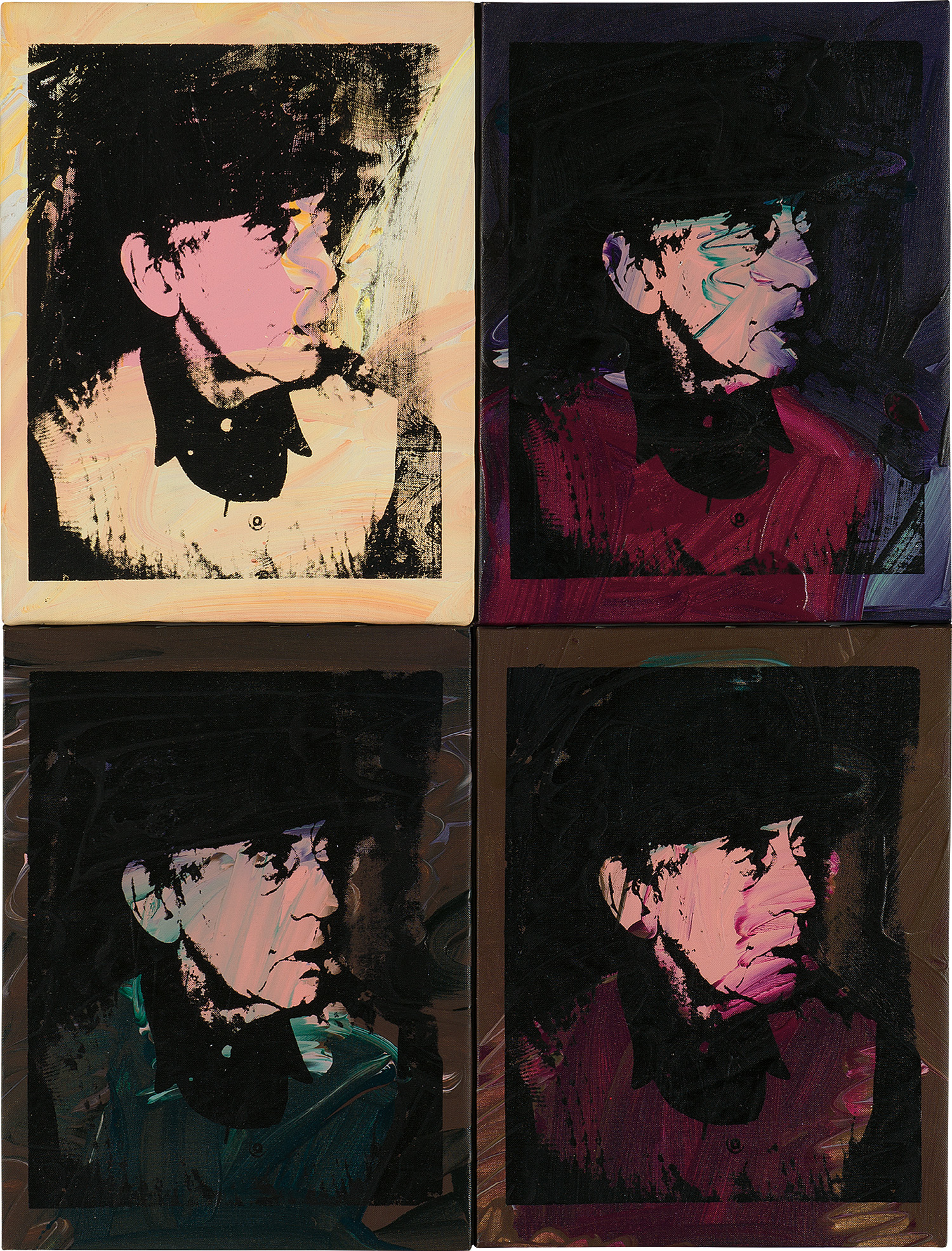

124Ο
Andy Warhol
Four works: (i-iv) Man Ray
(ii, iv) signed and dated "Andy Warhol 1974" on the reverse
(ii) 15 7/8 x 12 in. (40.4 x 30.5 cm.)
(iii) 16 1/8 x 12 in. (41 x 30.5 cm.)
(iv) 15 7/8 x 12 1/4 in. (40.6 x 31 cm.)
Full-Cataloguing
In April 1974, a young Italian dealer named Luciano Anselmino commissioned Andy Warhol to make a series of portraits of Man Ray. Enthused by an encounter he had orchestrated between the two creative giants the previous year, Anselmino had imagined producing a collaborative publication between the two, which would include creative contributions by Jasper Johns and Henry Miller, and use the Man Ray portraits as a cover and frontispiece for the volume. Though this ambitious project never materialized as planned, it gave way to a cycle of works comprising a total of 43 canvases: 28 works responding to Anselmino’s particular demands, and 15 additional paintings, including 11 smaller canvases, that Warhol created on his own terms and kept for himself.
Of the latter group of smaller paintings, two are housed in Tate, London, and National Galleries of Scotland collections, and one resides in the New Britain Museum of American Art, New Britain, Connecticut. Signifying their lasting value and importance within the artist’s oeuvre, Four Works: Man Ray, 1974, also pertain to the second cycle of smaller Man Rays. They brim with a turbulent exuberance that is redolent of Abstract Expressionist fervor, and exude a rare intimate feel that reveals the mutual admiration between Warhol and Man Ray.
Plunged in swathes of painterly color, each work from Four Works: Man Ray displays a delectable wet-on-wet mixture of tonalities, layered with a clear acrylic medium that imparts the overall images with a thick, painterly feel. As irreverent strokes of Phthalo Green, Indo Orange and Dioxazine Purple run over Man Ray’s cheeks, eyes, hat and cigar, each composition comes to life, imparted with a gestural vigor that kindles the elder artist’s crystallized posture. The accentuated shadows around the edges of his face and the unexpected shafts of light piercing through certain areas of the work furthermore recall the eccentric contours and intriguing light plays pervading Man Ray’s own Solarisation works. Thrown into relief and displaying dissonant tones throughout, these paintings exemplify a style that additionally resembles the creative approach of stellar colorists such as Henri Rousseau and Henri Matisse.
Portraying a key figure of Surrealism and a pioneer of modern photography, Warhol’s Man Ray works have been celebrated as some of the artist’s most accomplished portraits, taking on unique painterly qualities. A pictorial mirror to Man Ray’s notoriously subversive character, Warhol’s portraits of him are rendered with equally vigorous strokes and free-flowing lines, eschewing the usual sleekness and glamorized stillness of previous painted subjects. As such, the Man Rays initiated what became a new hybrid category in Warhol’s oeuvre, in which distinctions between entrepreneurial content and "free subjects’" were blurred. Executed on the request of Man Ray’s gallerist in Turin, the Man Rays were nonetheless pursued by Warhol freely and in his own time, similar to his Last Supper, Ladies and Gentleman, and Athletes series. Perhaps Man Ray’s physique – Warhol described him as "adorable," "really cute," and "one of the oldest people I’d known" – intrigued the artist; or perhaps it was the dissonance in their photographic practice that piqued his interest. Anselmino cites the "private and personal, I should like to say, even sentimental nature" of Man Ray as a painterly theme; according to the gallerist, Warhol’s preference for him plays an undeniable part in the affectionate character of his rendition (Luciano Anselmino, quoted in The Andy Warhol Catalogue Raisonné: Paintings and Sculptures, 1970-1974, vol. 3, New York, 2004, p. 373).
Yet, though the popular narrative would have it that the two artists had chosen one another from longstanding mutual esteem, Timothy Baum declared that Man Ray had in fact never heard of Warhol, and that, conversely, Warhol "only loved him because of his name – Man Ray" (Andy Warhol, quoted in The Andy Warhol Catalogue Raisonné: Paintings and Sculptures, 1970-1974, vol. 3, New York, 2004, p. 369). Upon first meeting Man Ray, Warhol had indeed felt intimidated to the point of requiring Baum’s presence for stress alleviation. He then began directing his elder more freely as he warmed to his presence, asking him to remove his glasses, put a cigar to his mouth and tilt his head. In essence, the encounter was not the gargantuan event that was then made of it, but instead reflected a deeply human moment in which the connection between the two men flourished progressively. In the resulting portraits, this very real and intimate aspect becomes evident in a way that distinguishes the Man Rays from Warhol’s previous and subsequent set of portraits, including Marylin, Elvis, and Mao. Captured by an innocent eye and later manipulated through paint, Man Ray is raw and free of artifice; it contains the idiosyncrasies of a natural photograph seized à la volée.
Andy Warhol
American | B. 1928 D. 1987Andy Warhol was the leading exponent of the Pop Art movement in the U.S. in the 1960s. Following an early career as a commercial illustrator, Warhol achieved fame with his revolutionary series of silkscreened prints and paintings of familiar objects, such as Campbell's soup tins, and celebrities, such as Marilyn Monroe. Obsessed with popular culture, celebrity and advertising, Warhol created his slick, seemingly mass-produced images of everyday subject matter from his famed Factory studio in New York City. His use of mechanical methods of reproduction, notably the commercial technique of silk screening, wholly revolutionized art-making.
Working as an artist, but also director and producer, Warhol produced a number of avant-garde films in addition to managing the experimental rock band The Velvet Underground and founding Interview magazine. A central figure in the New York art scene until his untimely death in 1987, Warhol was notably also a mentor to such artists as Keith Haring and Jean-Michel Basquiat.